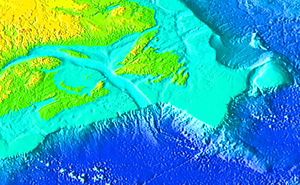Gulf of Saint Lawrence
Gulf of Saint Lawrence (French: golfe du Saint-Laurent), the world's largest estuary, is the outlet of North America's Great Lakes via the Saint Lawrence River into the Atlantic Ocean.
The river goes into the gulf through the Jacques Cartier Strait between the Côte-Nord region of Quebec and the north shore of Anticosti Island, and the Honguedo Strait between the south shore of Anticosti Island and the Gaspé Peninsula.
The gulf is bounded on the north by the Labrador Peninsula, to the east by Newfoundland, to the south by the Nova Scotia peninsula and Cape Breton Island, and to the west by the Gaspé and New Brunswick. It contains Anticosti Island, Prince Edward Island, and the Magdalen Islands.
It flows into the Atlantic through the Strait of Belle Isle between Labrador and Newfoundland, the Cabot Strait between Newfoundland and Cape Breton Island, and the Strait of Canso between Cape Breton Island and peninsular Nova Scotia. It should be noted that since construction of the Canso Causeway in 1955, the Strait of Canso does not permit free-flowing exchange of waters between the gulf and the Atlantic.
Besides the Saint Lawrence River itself, semi-major tributaries of the Gulf of Saint Lawrence include the Miramichi River, the Natashquan River, the Restigouche River, the Margaree River, and the Humber River. Arms of the Gulf include the Chaleur Bay, Miramichi Bay, St. George's Bay, Bay of Islands, and Northumberland Strait.
The first known exchange between Europeans and natives of the Gulf of St. Lawrence occurred in New Brunswick on July 7, 1534.
St. Paul Island, Nova Scotia, off the northeast tip of Cape Breton Island, is referred to as the "Graveyard of the Gulf" for its many shipwrecks. Bonaventure Island on the eastern tip of the Gaspé Peninsula, Île Brion and Rochers-aux-Oiseaux northeast of the Magdalen Islands are important migratory bird sanctuaries administered by the Canadian Wildlife Service. Canada maintains national parks in the Gulf of St. Lawrence estuary at Forillon on the eastern tip of the Gaspé, Prince Edward Island on the north shore of the island, Kouchibouguac on the northeast coast of New Brunswick, Cape Breton Highlands on the northern tip of Cape Breton Island, Gros Morne on Newfoundland's west coast, and a national park reserve in the Mingan Archipelago on Quebec's Côte-Nord.

Undersea features
The Laurentian Channel is a feature of the gulf floor that was formed during previous glaciations, where the continental shelf was eroded by the St. Lawrence River during periods of global sealevel minimums. Over the last century, the bottom waters of the channel have become hypoxic. [1]
The large extension of the continental shelf southeast of Newfoundland is known as the Grand Banks, and is the focus of fishing and oil exploration. Portions of the Grand Banks lie outside Canada's Exclusive Economic Zone. The easternmost portion of the shelf is known as the Flemish Cap, and it lies completely in international fishing waters.
Submarine canyons and fans can be found off the Scotian shelf.
Notes
- ^ Gilbert et al. (2005) "Limnology and Oceanography" 50(5):1654
